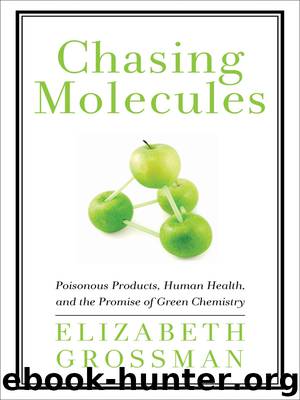Chasing Molecules by Elizabeth Grossman

Author:Elizabeth Grossman
Language: eng
Format: epub
ISBN: 9781610911573
Publisher: Island Press
Published: 2012-06-14T16:00:00+00:00
“Why weren’t we asking the right questions? Why didn’t we have the knowledge of why something is toxic?” Paul Anastas asks rhetorically when I speak to him in his office at Yale University, where he heads the Center for Green Chemistry and Engineering. “No one has been asking to make [the] reduction of hazard a performance criterion. We have to change the idea of environment as a constraint to performance and make it part of design criteria.”
It’s a sunny, warm October day in 2007 when I visit Anastas in New Haven, and Yale is in the midst of a renovation boom. Construction is going on everywhere, including at the Sterling Chemistry building, a gloomy, medieval-looking building that he calls “Hogwarts.” Anastas is approachable, very personable, and visibly excited about his work. His face lights up when he begins to answer my questions. He has a gently forceful and exceptionally clear way of speaking that I imagine was honed during his years in Washington, working with the Environmental Protection Agency, where he served as chief of the industrial chemistry branch from 1989 to 1998 before becoming assistant director for environment in the White House Office of Science and Technology Policy, a post he held from 1999 to 2004. In addition to teaching and working on policy, Anastas also works with businesses on green chemistry issues.
“I tend to be on the solutions side of things,” Anastas tells me. “We don’t just need to make people afraid, we need to get toxics out of our bodies and out of our newborns,” his conviction clearly is amplified by the pleasure he takes in telling me he’s recently become a father for the first time. “We need to know if a new material is safe or if it can be made safe.”
So how do we do that? I ask.
To begin with, says Anastas, we need to be asking a whole series of questions that we simply haven’t been asking while designing new materials. “Is it hazardous? What is its biological activity? What does the substance do to a body and what does the body do to the substance? Can it get into the body?” If so, what happens then? How is it absorbed and metabolized ? What organs might it target? Can it cross biological membranes or the blood-brain barrier? Is the substance persistent and will it bioaccumulate? These are the questions Anastas and John Warner have incorporated into their principles of green chemistry. And they are essential to the narrative Warner is so passionate about bringing back to the science of creating new materials.
Answering these questions, Anastas explains, means looking at a substance’s fundamental physical characteristics, beginning with its solubility. Solubility is important because whether a substance is soluble in water or fat determines how persistent a substance will be. A substance that is soluble in fat will tend to find its way into plant and animal cells where it may interact chemically with other cellular materials. If that plant or animal is a food source, then that fat-soluble substance can then begin its climb up the food web.
Download
This site does not store any files on its server. We only index and link to content provided by other sites. Please contact the content providers to delete copyright contents if any and email us, we'll remove relevant links or contents immediately.
| Acoustics | Bridges |
| Earthwork Design | Environmental |
| Fire Science | Highway & Traffic |
| Hydrology | Remote Sensing |
| Seismic Design | Structural |
| Structural Dynamics | Surveying & Photogrammetry |
| Transportation |
Whiskies Galore by Ian Buxton(40332)
Introduction to Aircraft Design (Cambridge Aerospace Series) by John P. Fielding(32338)
Small Unmanned Fixed-wing Aircraft Design by Andrew J. Keane Andras Sobester James P. Scanlan & András Sóbester & James P. Scanlan(32141)
Craft Beer for the Homebrewer by Michael Agnew(17446)
Turbulence by E. J. Noyes(7039)
The Complete Stick Figure Physics Tutorials by Allen Sarah(6638)
Kaplan MCAT General Chemistry Review by Kaplan(6054)
The Thirst by Nesbo Jo(5785)
Bad Blood by John Carreyrou(5769)
Learning SQL by Alan Beaulieu(5412)
Weapons of Math Destruction by Cathy O'Neil(5037)
Man-made Catastrophes and Risk Information Concealment by Dmitry Chernov & Didier Sornette(4736)
iGen by Jean M. Twenge(4702)
Digital Minimalism by Cal Newport;(4541)
Life 3.0: Being Human in the Age of Artificial Intelligence by Tegmark Max(4507)
Audition by Ryu Murakami(4099)
1,001 ASVAB Practice Questions For Dummies by Powers Rod(4038)
Electronic Devices & Circuits by Jacob Millman & Christos C. Halkias(4027)
Pale Blue Dot by Carl Sagan(4001)
